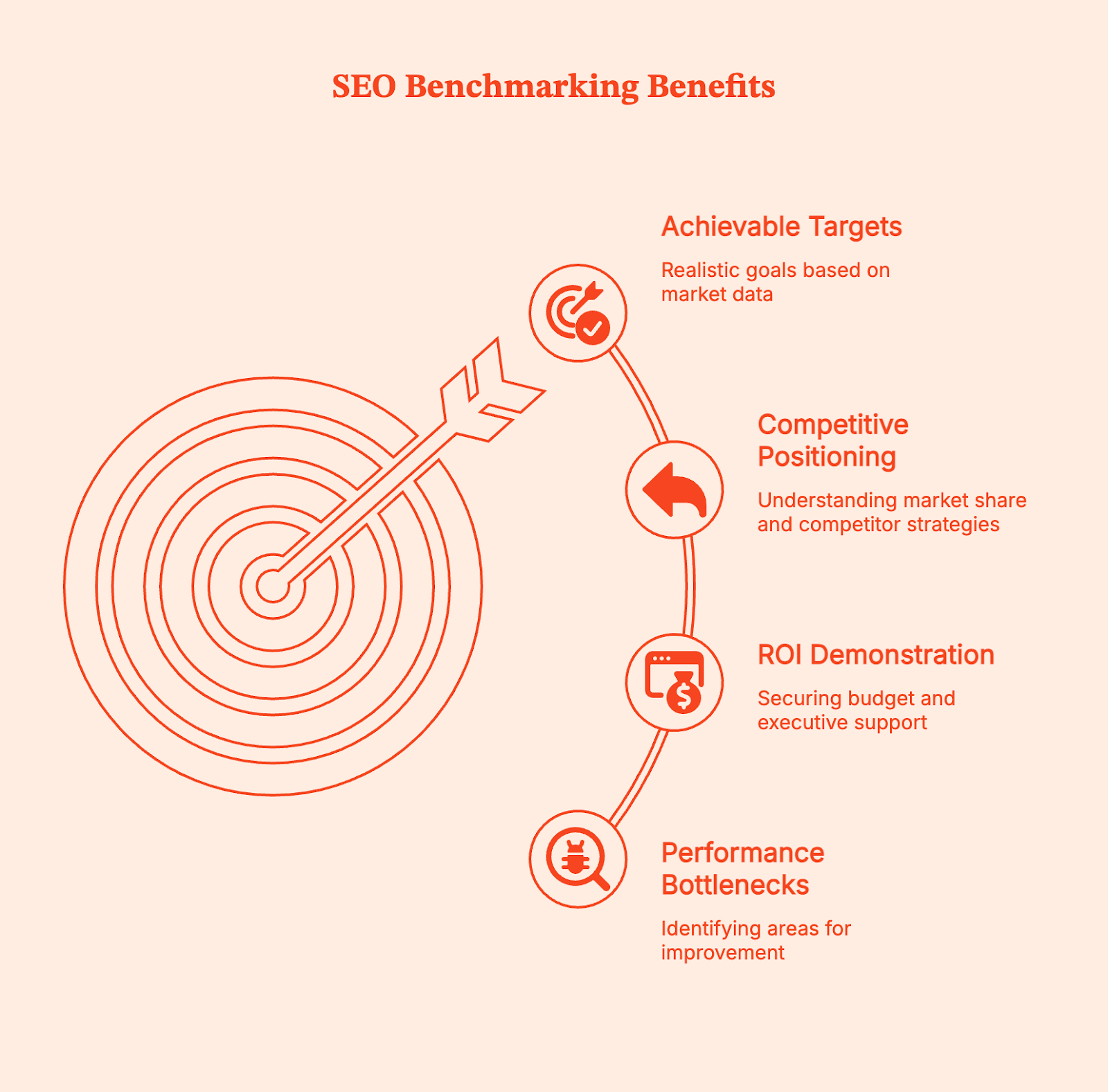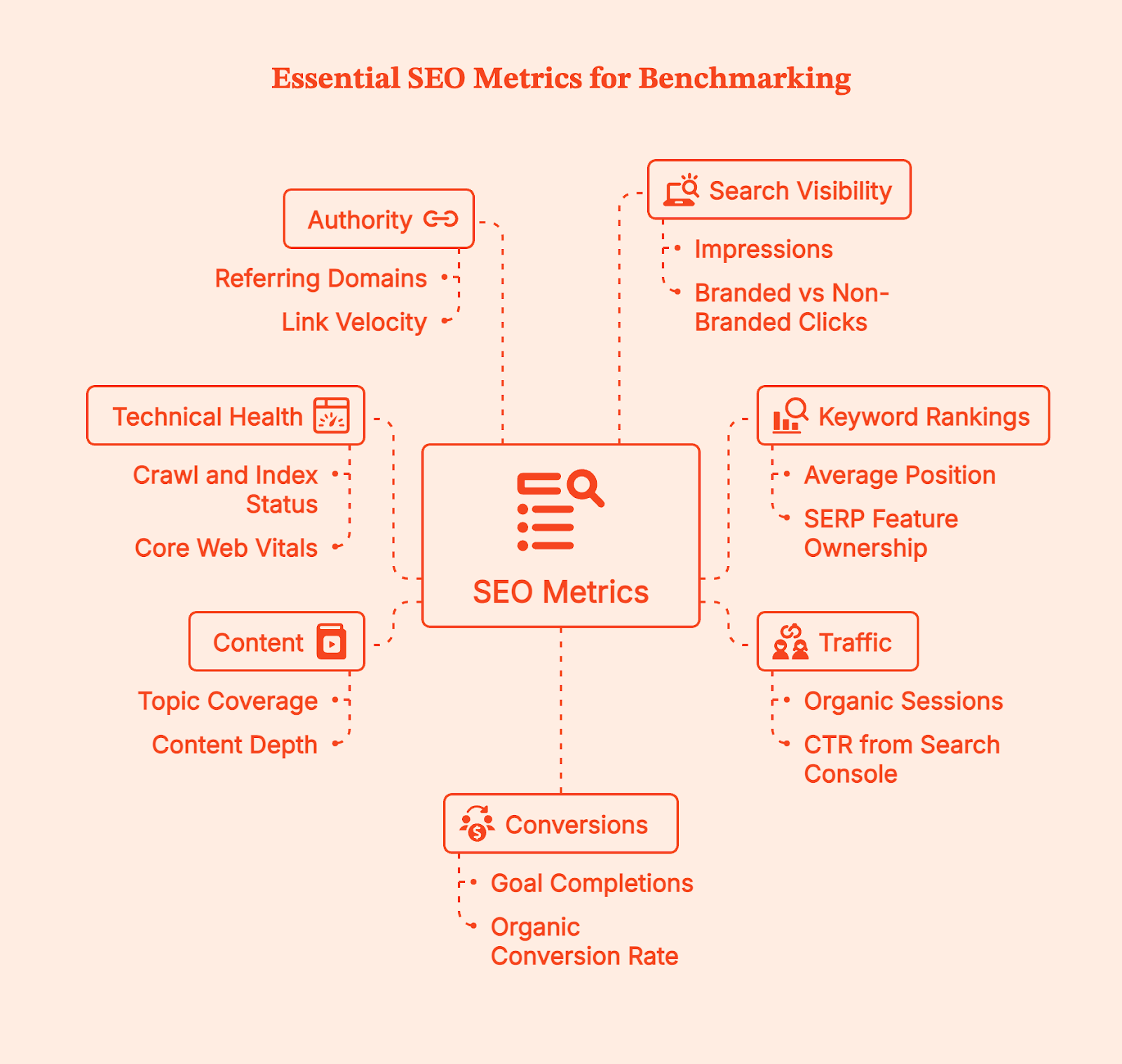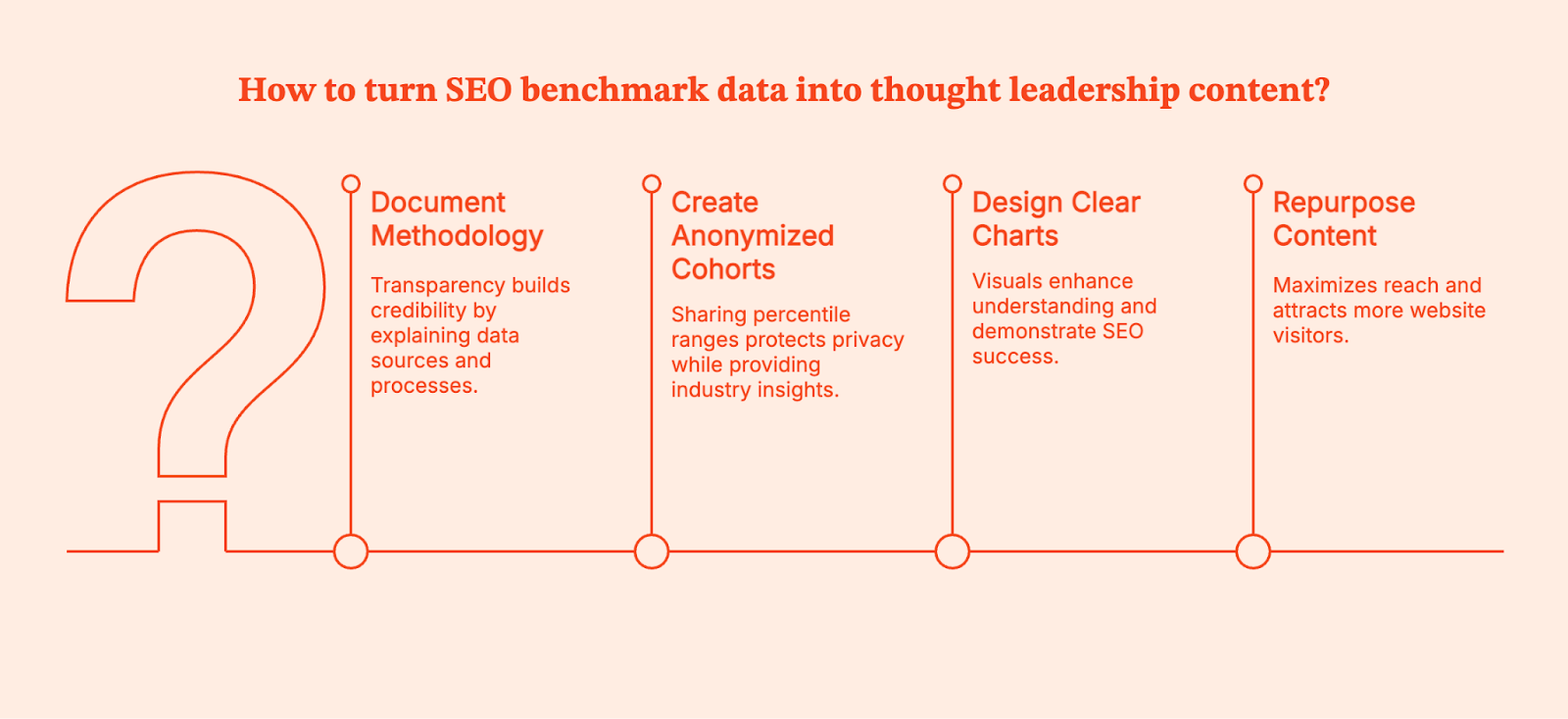Search engine optimization is a long game. Like… training-for-a-marathon long. You don’t wake up one morning magically ranking #1 (if only). But as your SEO efforts mature, you start collecting all kinds of shiny numbers, rankings, clicks, traffic charts that go up, down, and sometimes sideways.
But the BIG question is: Are those numbers actually good?
That’s where SEO benchmarking steps in (the reality check you actually need). It helps you compare your performance against something meaningful, your past results, your competitors’ wins, or the wider industry’s average pulse.
In this blog, we’re breaking down how to set benchmarks that matter (not just vanity metrics), which numbers to track without losing your sanity, and how to turn all that data into actions that genuinely move the needle.
TL;DR:
- Know if your SEO is actually working. Compare your metrics to past performance, competitors, or industry standards.
- Stop guessing which metrics matter. Track search visibility, keyword rankings, organic search traffic, conversions, content quality, and technical health.
- Follow a proven 7-step process. Define scope, pick KPIs, gather data, add competitors, normalize, analyze gaps, and set targets.
- Turn data into action. Identify what's holding you back and where to double down.
- Report strategically. Weekly on issues, monthly on progress, quarterly on strategy.
- Avoid vanity metrics. Focus on benchmarks that drive real business growth.
What is SEO Benchmarking?
Think of benchmark SEO as setting reference points for measuring your search performance. Let's say your site had 10,000 organic sessions last month. That's your benchmark. Now, your goal might be to hit 15,000 sessions next quarter.
The benchmark becomes your baseline expectation that you need to exceed, not a target you must achieve.
But benchmarking SEO performance only works when you're comparing your numbers to something specific. That could be your past performance, what your competitors are doing, or industry averages. Without these reference points, you're just collecting numbers without any real context.
Benchmarks vs KPIs vs Metrics in SEO
You'll often hear these three terms used interchangeably, but they actually play different roles in how you measure and strategize your SEO efforts. Let me break down what each one means.
These three elements work together to create your measurement framework.
Key metrics give you the raw numbers, benchmarks provide the context for those numbers, and KPIs point you in the right direction. When all three are working together, you've got a solid foundation.
Without them, you're either drowning in meaningless data or setting goals without knowing if they're even realistic
Why Does SEO Benchmarking Matter?
Without benchmarks, you see numbers go up or down, but can't really tell if you're winning or losing. Good benchmarking helps you turn raw data into insights that help drive improvements.

So what can effective benchmarking actually reveal? Let me walk you through it:
- Identifying Performance Bottlenecks
Benchmarking shows you exactly where your SEO strategy is falling apart.
Maybe your blog posts rank well and bring in traffic, but your product pages are stuck on page two. That tells you exactly where to focus your content optimization efforts.
On the flip side, you may be getting tons of clicks from search engine results pages, but if your conversions are lagging behind industry standards, the real problem isn't visibility but your landing page experience, how clear your offer is, or whether you're targeting the right people.
When you benchmark different content types, funnel stages, and user segments against each other, these patterns become crystal clear. Instead of spreading your resources thin across everything, benchmarking pinpoints the specific bottlenecks that, once you fix them, will give you the biggest wins.
- Demonstrating ROI and Securing Buy-In
Benchmarking gives you the proof you need to secure budget, headcount, and executive support. Without hard numbers, search engine optimization SEO stays stuck in the "nice to have" category.
Maybe you've been running SEO campaigns for six months, organic search traffic is climbing, but when budget season rolls around, leadership asks, "What's the actual return?"
If all you can say is "keyword rankings improved" or "we're getting more traffic," you're competing for resources with channels that show clear revenue impact.
But when you can walk into that meeting and say, "Our organic traffic jumped 42% quarter over quarter, our top 3 rankings doubled from 15 to 30 keywords, and our organic conversion rate climbed from 2.1% to 3.4%," you're speaking the language of business results.
That's measurable growth tied directly to the bottom line.
This is where benchmarking turns SEO into a strategic priority because it demonstrates ROI in terms that leadership actually cares about.
- Understanding Competitive Positioning
SEO performance doesn't exist in a vacuum. Let's say your organic traffic grew 10% but your competitors grew 40% during the same period. In reality, you're actually losing market share. Industry benchmarks show you whether you're keeping pace, pulling ahead, or falling behind.
On top of that, competitor analysis reveals what's actually possible when you have similar resources. It helps you pinpoint the specific areas where competitors are outperforming you, whether that's content depth, technical performance, backlink acquisition, or SERP feature ownership.
This context becomes absolutely critical when you're setting realistic expectations and figuring out which initiatives will close the most important gaps.
- Setting Achievable, Data-Driven Targets
Goal setting without benchmarks is guesswork.
You might target 100,000 monthly visits just because it sounds like a nice round number, even though competitors with similar resources and market position are only getting 50,000.
Benchmarking grounds your targets in what's actually realistic.
For example, if competitors in your space with comparable domain authority and content volume are hitting 3.5% CTR, that becomes a meaningful target instead of just some abstract aspiration. Goals driven by benchmarks are way more likely to earn stakeholder buy-in because they're rooted in demonstrated market performance rather than wishful thinking.
Now, all these benefits only work if you're tracking the right metrics and comparing them against meaningful reference points.
Now, all these benefits only work if you're tracking the right metrics and comparing them against meaningful reference points.
Essential SEO Metrics to Benchmark: What to Track for Maximum Impact

You can track endless data, but these are a few important metrics you must start with before adding anything else to your list.
- Search Visibility: Impressions (how often you appear in results), branded keywords vs non-branded clicks (are people finding you or searching for you?), total ranking keywords, and share of voice (your percentage of available clicks).
- Keyword Rankings: Average position for priority keywords, percentage in top 3 and top 10 (position 1 gets 28% of clicks, position 10 gets under 2%), and SERP feature ownership (snippets, People Also Ask boxes).
- Traffic: Organic sessions, CTR from Search Console (varies by industry: healthcare averages 3.3%, legal 6.6%), and average engagement time.
- Conversions: Goal completions, organic conversion rate, lead quality (MQL/SQL rates), and revenue attribution.
- Content: Topic coverage vs competitors, content depth compared to top results, and freshness.
- Technical Health: Crawl and index status, Core Web Vitals (LCP, FID, CLS), site speed, broken links, and internal linking.
- Authority: Referring domains (backlinks remain a top factor), link velocity, and domain authority scores.
Here's the thing, though: tracking these metrics for your own site is just the starting point. Your website performance only really makes sense when you stack it up against competitor performance.
How to Conduct Competitive SEO Benchmarking?
Your business competitors aren't always your search competitors.
For instance, an analytics platform might compete with sales enablement tools for keywords like 'revenue performance dashboard' or 'pipeline visibility,' even though they solve completely different problems.
So, how do you find your real search competitors? Search your target keywords and take note of who consistently appears in the top 10. If they rank for 60% of your tracked keywords, they're a direct competitor.
Once you've identified your competitors, you'll want to run some gap analyses:
- Keyword gap: What are they ranking for that you're not?
- Content gap: What topics have they covered in depth that you've barely touched?
- Backlink gap: Where are they getting links that you're not?
- SERP feature gap: Are they owning snippets for keywords where you rank but don't have features?
After that, you'll want to measure the delta. If a competitor gets 50,000 monthly visits and you get 20,000, that's a 2.5x gap. You can break this down by category to figure out where to focus your efforts.
Beyond just understanding these gaps, you'll also need to run a systematic benchmark that captures all this data.
How to Run a Complete SEO Benchmark: A 7-Step Process for Measuring Performance

To run an effective SEO benchmark, you need a structured approach. Here are seven steps that'll help you establish meaningful baselines, spot opportunities, and set achievable targets.
Step 1: Define Your Benchmark Scope
First things first: what exactly are you benchmarking? Think about whether you're measuring your entire site, a specific product category, a content hub, or a particular funnel.
Your scope should align directly with your business goals. If you're launching a new SaaS platform for lawyers, benchmark that category specifically. If you're trying to build thought leadership, focus on your blog or resource center.
Trying to benchmark everything at once dilutes your focus and makes it harder to identify actionable patterns. If the objective is to increase demo requests, you'll prioritize conversion metrics and commercial intent keywords rather than top-of-funnel traffic.
Step 2: Select KPIs and Establish Baseline Benchmarks
You'll want to select 10-15 SEO key performance indicators that directly align with your defined goals. It's easy to get swayed and track all possible metrics, but focusing only on the ones that absolutely matter will give you the clearest insights.
Each KPI needs a precisely documented baseline. If your goal is to increase conversions by 25%, you need to know your exact starting point: current conversion count, conversion rate, and the time period measured.
Consistent measurement windows (e.g., 30 days, 90 days) help ensure accuracy, and documenting any seasonal factors that might affect your baseline is equally important. This baseline becomes your primary reference point for measuring SEO progress.
Step 3: Assemble Your Data Sources
Effective benchmarking requires pulling data from multiple sources to get a complete picture.
At minimum, you'll need:
- Google Search Console for impressions, clicks, CTR, and average position
- Google Analytics for traffic patterns, user behavior, and conversion tracking
- A rank tracker for historical ranking data and competitor visibility
- A crawl tool like Screaming Frog or Sitebulb for technical SEO metrics
- And a backlink index, such as Ahrefs or Semrush, for backlink profile analysis
Setting up regular data exports or API connections means you can track search engine rankings over time without manual data gathering eating up your schedule.
Step 4: Build Your Competitive Set
You'll then need to identify 3-5 direct search competitors. They don't necessarily need to be business competitors, but the sites that consistently rank for your target keywords.
Keyword overlap serves as your primary filter: if a site ranks for 40% or more of your priority keywords, they're a direct search competitor.
They should also target similar audiences and have comparable resources (similar domain authority, content volume, team size). It's best to avoid comparing yourself to industry giants with 10x your resources and instead focus on competitors you can realistically overtake with strategic execution.
Step 5: Normalize Your Data for Fair Comparison
Data consistency is critical for accurate benchmarking. Use identical date ranges for all comparisons. For instance, compare January to January, not January to December, to account for seasonality.
If you're comparing mobile performance, make sure all data sources are filtered to mobile devices.
If you operate in specific markets, geographic regions need to align as well. When comparing to competitors, using the same seo tools and settings is essential. Inconsistent data normalization leads to false conclusions and misguided strategy decisions.
Step 6: Analyze Gaps and Prioritize Opportunities
Once your data is normalized, you can identify the biggest gaps between your SEO performance and your benchmarks (both historical and competitive).
Patterns will start to emerge: Are you losing ground in specific content categories? Do competitors dominate certain SERP features?
Technical performance might be holding you back.
The ICE framework helps you prioritize fixes: Impact (how much will this move the needle?), Confidence (how sure are you it will work?), and Ease (how quickly can you implement it?).
Quick wins include fixing technical errors that block high-value pages, updating thin content on keywords where you rank on page 2, and adding internal links to orphaned content that's not getting crawled effectively.
Step 7: Set Specific Targets and Schedule Reviews
Set concrete, measurable targets with clear owners and a deadline.
For instance, "Increase non-branded sessions from product pages by 30% by Q3, owner: Sarah" is far more actionable than "improve traffic."
Additionally, break large goals into monthly milestones, allowing you to course-correct quickly if you're falling behind.
Schedule your next review based on your site's velocity: monthly reviews work for most sites, quarterly reviews suit slow-moving industries or smaller sites, and weekly reviews are appropriate for high-velocity businesses like news sites or large e-commerce platforms with frequent inventory changes.
How to Structure an Effective SEO Keyword Benchmark Report

Structure your report with these columns:
- Core data: Keyword cluster (group related terms), search intent (informational/commercial/transactional), current rank, rank trend, CTR, clicks, and page mapping (which page targets this given keyword).
- Analysis: Content depth vs competitors (thin/adequate/comprehensive), internal links pointing to page, primary competitors in positions 1-3, and backlink notes.
- Action: Next specific action ("rewrite intro", not "optimize"), owner, and due date.
Then, set up views for regional, device type, brand vs non-brand, and intent type.
Create three sections:
- Top Movers: Biggest ranking changes (up/down) in 30 days
- Quick Wins: Keywords in positions 4-10 where small improvements drive more traffic
- Blocked by Tech: High-value keywords where technical issues prevent better performance
The structure matters, but so does timing. Different stakeholders need different reporting frequencies.
How Often Should You Review SEO Benchmarks and Set Performance Targets?
- Weekly: Track critical changes only: major ranking shifts, technical errors, traffic anomalies. Flag what needs immediate attention.
- Monthly: Compare benchmarks to targets. Review traffic/conversion trends, ranking progress, new SEO content performance, and technical health. Did you hit goals? Where are you ahead or behind?
- Quarterly: Full benchmark reset. Compared to the previous quarter and year-over-year. Reassess competitive set. Answer bigger questions: Are content pillars working? Should we shift the budget? Do we need different keywords?
Essential SEO Benchmarking Tools and Ready-to-Use Templates
- All-in-one platforms: Ahrefs, Semrush, or Moz handle seo keyword research, position tracking, backlink monitoring, and competitive research. Ahrefs excels at backlink data, Semrush has strong PPC integration, and Moz focuses on simplicity.
- Site crawlers: Screaming Frog or Sitebulb find technical issues. Run monthly crawls to benchmark health.
- Best keyword research tools: Google Keyword Planner for search volume and keyword ideas, Ahrefs Keywords Explorer for related keywords and search queries, and Semrush Keyword Magic Tool for building a comprehensive keyword list with niche keywords.
- Essentials: Google Analytics for analytics tracking and Google Search Console (impressions, clicks, CTR, position). Non-negotiable for website owners and SEO professionals.
- Dashboards: Google Data Studio, Tableau, or Databox visualize benchmarks and automate client reporting.
- Third-party tools: Consider specialized tools like Google Business Profile for local businesses and other SEO tools for link building and on page SEO analysis.
- Template structure: Include sheets for an overview dashboard, keyword performance by cluster, competitive comparison grid, technical health checklist (including meta descriptions, meta title, and page SEO), content gap analysis, and monthly snapshots.
Beyond internal tracking, your benchmark data has another valuable use: thought leadership.
How to Turn Your SEO Benchmark Data into Thought Leadership Content

The steps you take to successfully benchmark SEO data can be used to create content for people struggling with the same. Here's how you can easily create thought leadership content:
- Document methodology: Explain date ranges, tools, and sample size. Transparency builds credibility when discussing your content strategy.
- Create anonymized cohorts: Group by industry, company size, or traffic level. Share percentile ranges, not specific numbers: "Median healthcare CTR was 3.2%, 75th percentile at 4.1%."
- Design clear charts: One insight per chart. Show benchmark ranges, year-over-year trends, and performance distribution to demonstrate SEO success.
- Repurpose everywhere: Break into 5-10 blog posts, create social graphics with stats, pitch publications with exclusive findings, build sales materials, and update annually to attract more website visitors.
This content drives organic search traffic, builds authority, and gives your sales team data for conversations. It also helps you compare organic results against Google Ads campaigns to understand your full search presence.
In a Nutshell…
I’m hoping that by now you agree that SEO benchmarking is all about making that data work for you.
By comparing performance to meaningful baselines, competitors, and market standards, you move from aimless reporting to focused, strategic action. When you set the right scope, choose metrics that align with business outcomes, and analyze consistently over time, benchmarking becomes the signal.
This guide gave you a step-by-step process to track what truly matters, spot opportunities where others overlook them, and report in a way that resonates with decision-makers. Whether you’re tracking performance monthly or reviewing quarterly trends, benchmarking helps you sharpen focus, improve ROI visibility, and stay one step ahead of your search competition.
Bottom line: good SEO is about knowing what’s working, what’s not, and what’s next.
FAQs for SEO Benchmarking
Q. What does an SEO report mean?
A. A summary of performance vs goals and benchmarks, with insights and next steps. Not a data dump. Good reports answer three questions: Where are we? How does that compare? What do we do next?
Q. How often should I benchmark?
A. Track weekly for issues, review monthly against benchmarks, and realign quarterly for strategy. Adjust based on site scale and volatility.
Q. What are good benchmarks for CTR and conversions?
A. CTR varies by industry: healthcare, 3.3%, legal, 6.6%. Compare these to Google Ads benchmarks for a full picture. E-commerce conversion averages 2.5-3%, B2B leads 2-5%. Your baseline matters more than industry averages. Focus on improving your own performance and track keyword rankings consistently.
Q. Which tools are best for competitive benchmarking?
A. Combine Semrush or Ahrefs (keywords, content, backlinks), Screaming Frog (technical), and Google Search Console + Google Analytics (your own data). All-in-one platforms handle most needs for tracking keyword performance.
Q. How do I create a compelling keyword report for leadership?
A. Lead with goals and changes. Start with a one-page summary showing status vs goals, three wins, three risks, and top actions for 90 days. Use visuals and color coding: green for on-target clusters, yellow for at-risk, red for problems. Show the 30 highest-value keywords, not all 500. End with clear budget or approval requests tied directly to benchmark gaps.
.svg)






